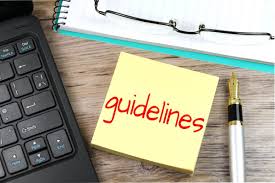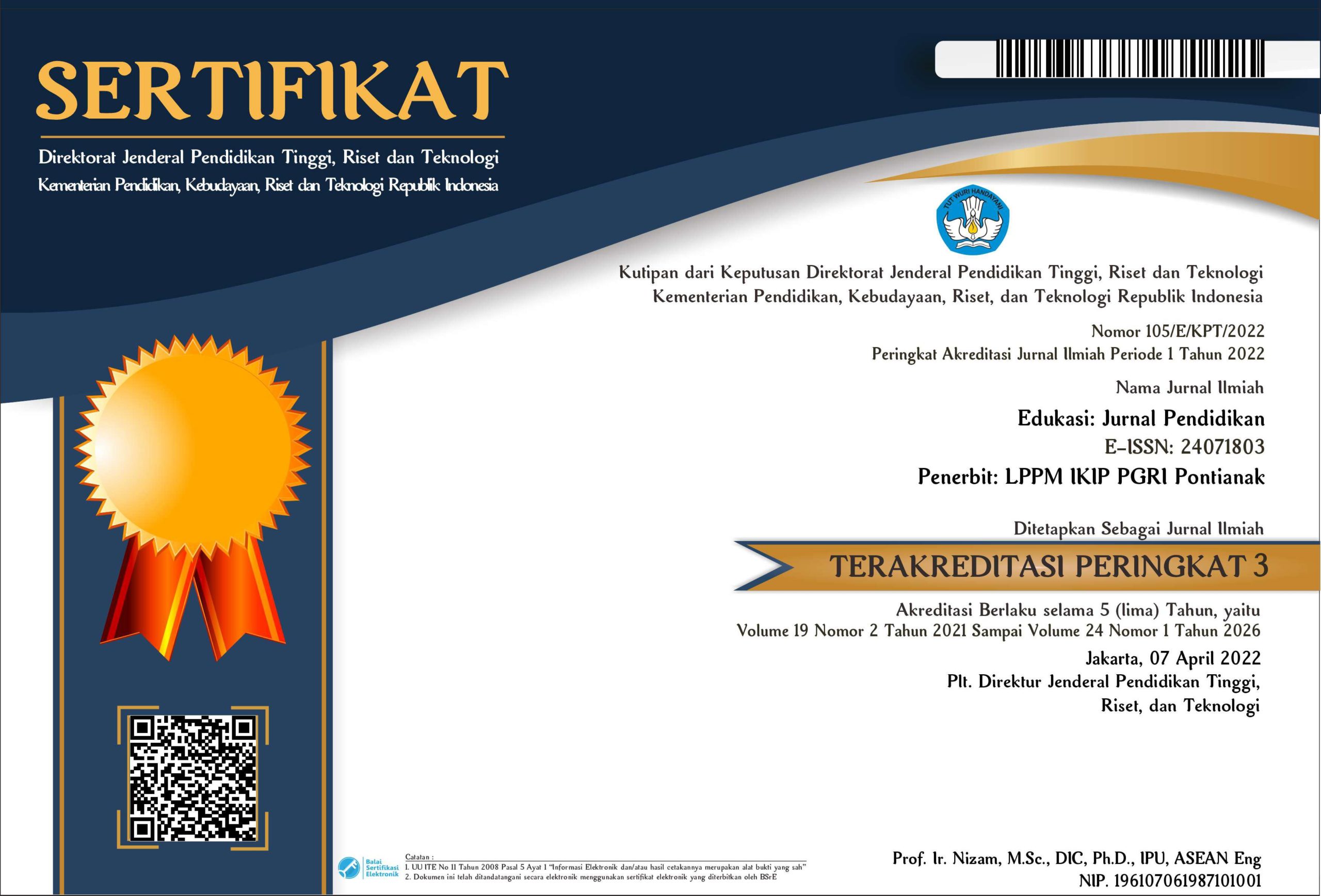Perbandingan Blended Learning dan Face-To-Face Learning terhadap Kemampuan Komunikasi Mahasiswa pada Proyek Desain Website
DOI:
https://doi.org/10.31571/edukasi.v18i1.1630Keywords:
pembelajaran berbasis proyek, blended learning, komunikasi, desain website, project-based learning, communication, website designAbstract
Abstrak
Penelitian bertujuan untuk mengetahui perbedaan kemampuan komunikasi mahasiswa setelah melaksanakan proyek pembuatan desain website menggunakan model pembelajaran Blended Learning (BL) dan pembelajaran tatap muka/face-to-face (F2F). Metode penelitian yang digunakan adalah metode eksperimen dengan bentuk penelitian adalah kuasi eksperimen. Populasi penelitian berjumlah 696 mahasiswa dan sampel penelitian berjumlah 63 mahasiswa yang diambil menggunakan teknik purposive sampling. Sampel penelitian dibagi menjadi dua kelas, yaitu kelas yang melaksanakan BL dan kelas yang melaksanakan pembelajaran F2F. Alat pengumpul data dalam penelitian ini berupa portofolio dan lembar observasi. Teknik analisis data menggunakan analisis deskriptif dan analisis multivariat. Hasil analisis menunjukkan bahwa kemampuan komunikasi mahasiswa berada dalam kategori baik dan terdapat perbedaan kemampuan komunikasi pada proyek desain website antara kelompok yang melaksanakan BL dan F2F.
Â
Abstract
The research aimed to determine differences in student communication skills after implementing a website design project using Blended Learning (BL) learning model and face-to-face learning (F2F). The research method used an experimental method with the form of research was quasi-experimental. The study population numbered 696 students and the study sample numbered 63 students taken using purposive sampling techniques. The research sample divided into two classes, namely classes that carry out BL and classes that carry out F2F learning. Data collection tools were in the form of portfolios and observation sheets. Data analysis techniques using descriptive analysis and multivariate analysis. The analysis showed that the communication skills of students are in good category and there are differences in communication skills in website design projects between groups implementing BL and F2F.
Downloads
References
Abbas, L. 2015. Applying Blended Learning to English Communication Courses 101 and 102 at BZU/Palestine (Case Study). Palestinian Journal of Open Education, 5(9): 31-64.
Afriana, J., Permanasari, A., & Fitriani, A. 2016. Project Based Learning Integrated to STEM to Enhance Elementary School's Students Scientific Literacy. Jurnal Pendidikan IPA Indonesia, 5(2): 261-267.
Ahmed, F. & Capretz, L. F. 2012. Soft Skills Requirements in Software Development Jobs: A Cross-Cultural Emperical Study. Journal System and IT, 14(1): 58-81.
Ahmed, F., Capretz, L. F., Bouktif, S., & Campbell, P. 2013. Soft Skills and Software Development: A Reflection from Software Industry. International Journal of Information Processing and Management, 4(3): 171-191.
Alves, A.C., Leão, C.P., Moreira, F., & Teixeira, S. 2017. Project-Based Learning and Its Effects on Freshmen Social Skills in an Engineering Program dalam Otero-Mateo, Manuel & Pastor-Fernandez, Andres (Editor). Human Capital and Competences in Project Management. London: IntechOpen.
Arikunto, S. 2014. Evaluasi Program Pendidikan. Jakarta: Bumi Aksara.
Dziuban, C., Graham, C., Mokal, P., Norberg, A., & Sicilia, N. 2018. Blended Learning: The New Normal and Emerging Technologies. International Journal of Educational Technology in Higher Education, 15(3): 1-16.
Eggleston, A. G. & Rabb, R. J. 2018.Technical Communication for Engineers: Improving Professional and Technical Skills. Proceedings of the American Society for Enggineering Education 2018 Annual Conference, Salt Lake City: Juni 2018. Hal: 118-129.
Evtyugina, A. A., Simonova, M. V., & Fedorenko, R. V. 2016. Teaching Conversational Language Skills to Foreign Students: Blended Learning and Interactive Approaches. IEJME-mathematics Education, 11(8): 2925-2936.
Ghahari, S. 2013. The Effect of Blended Learning vs. Classroom Learning Techniques on Iranian EFL Learners’ Writing. International Journal of Foreign Language Teaching & Research, 1(3): 77-86.
Harahap, F., Nasution, N. E. A., & Manurung, B. 2019. The Effect of Blended Learning on Student's Learning Achievement and Science Process Skills in Plant Tissue Culture Course. International Journal of Instruction, 12(1): 521-538.
Hinampas, R. T., Murillo, C., Tan, D., & Layosa, R. 2018. Blended Learning Approach: Effect on Students' Academic Achievement and Practical Skills in Science Laboratories. International Journal of Scientific & Technology Research, 7(11): 63-69.
Huang, Q. 2016. Learners’ Perception of Blended Learning and the Roles and Interaction of F2F and Online Learning. ORTESOL Journal, 33(2016): 14-33.
Jeffrey, L. M., Milne, J., & Suddaby, G. 2014. Blended Learning: How Teachers Balance the Blend of Online and Classroom Components. Journal of Information Technology Education: Research, 13(2014): 121-140
Kashefi, H., Ismail, Z., & Yusof, M. Y. 2012. The Impact of Blended Learning on Communication Skills and Teamwork of Engineering Students in Multivariable Calculus. Procedia-Social and Behaviorial Science, 56(2012): 341-347.
Kovalyova, Y. Y., Soboleva, A. V., & Kerimkulov, A. T. 2016. Project Based Learning in Teaching Communication Skills in English as a Foreign Language to Engineering Students. International Journal of Emerging Technologies in Learning, 11(4): 153-164.
Lalima & Dangwal, K. L. 2017. Blended Learning: An Innovative Approach. Universal Journal of Educational Research, 5(1): 129-136.
Lesmana, C. & Arpan, M. 2017. Penerapan Model Project Based Learning terhadap Kemampuan Psikomotor, Aktivitas Belajar, dan Respon Mahasiswa. Jurnal Pendidikan Informatika dan Sains, 6(1): 8-19.
Madjid, A. 2013. Strategi Pembelajaran. Bandung: PT Remaja Rosdakarya.
Morton, C., Saleh, S., Smith, S., Hemani, A., Ameen, A., Bennie, T., & Toro-Troconis, M. 2016. Blended Learning: How can We Optimise Undergraduate Student Engagement? BMC Medical Education, 16(195): 1-8.
Musa, F., Mufti, N., Latiff, R. A., & Amin, M. M. 2012. Project-Based Learning (PjBL): Inculcating Soft Skills in 21st Century Workplace. Procedia-Social and Behaviorial Science, 59(2012): 565-573.
Onong, U. E. 2000. Ilmu, Teori, dan Filsafat Komunikasi. Bandung: Citra Aditya Bakti.
Permana, G. Y. 2017. The Effect of Using Blended Learning Strategy toward the 8 Grade Students’ Writing Competency. Journal of Psychology and Instruction, 1(2): 79-87.
Rahman, A. M. 2018. English Writing Performance Using Blended Learning in TVET Education. Language Literacy, 2(1): 28-36.
Sabirin, F. 2016. Peningkatan Kreativitas dan Kolaborasi Mahasiswa melalui Pembelajaran Berbasis Proyek pada Mata Kuliah Pemrograman di Politeknik Negeri Pontianak. Jurnal Pendidikan Informatika dan Sains, 5(2): 195-211.
Saenab, S., Yunus, S. R., Saleh, A. R., Virninda, A. N., Hamka, L., & Sofyan, N. A. 2018. Project-Based Learning as the Atmosphere for Promoting Students' Communication Skills. Journal of Physics: Conference Series, 1028(2018): 012026.
Smith, C. M. 2015. Implementing and Evaluating a Blended Learning Format in the Communication Interhsip Course. Journal of Information Technology Education: Innovations in Practice, 14(1): 271-235.
Snodin, N. S. 2013. The Effects of blended Learning with a CMS on the Development of Autonomous Learning: A Case Study of Different Degrees of Autonomy Achieved by Individual Learners. Computers & Education, 61(1): 209–216.
Sriarunrasmee, J., Techataweewan, W., & Mebusaya, R. P. 2015. Blended Learning Supporting Self-Directed Learning and Communication Skills of Srinakharinwirot University's First Year Students. Procedia - Social and Behavorial Sciences, 197(2015): 1564-1569.
Sumarni, W. 2015. The Strengths and Weaknesses of the Implementation of Project Based Learning: A Review. International Journal of Science and Research, 4(3): 478-484.
Susilowati, N., & Latifah, L. 2016. The Implementation Effect Blended Learning Approach on Accounting Knowledge and Generic Skills. Journal of Accounting and Business Education, 1(1): 66-76.
Trisdiono, H. 2014. Project-Based Learning in Teachers' Perspectives. DIJE, 2(5): 34-40.
Udacity. 2017. Ulitmate Skills Checklist for Your First Front-End Develper Job dalam https://www.udacity.com/wp-content/uploads/2015/03/Udacity-UltimateFront-EndWebDeveloperCareerGuide.pdf. Diakses 8 Februari 2019.
Vernandakis, N., Giannousi, M., Derri, V., Michalopoulos, M., &
Kioumourtzoglou, E. 2012. The Impact of Blended and Traditional Instruction in Student's Performance. Procedia Technology, 1(2012): 439-443.
Wagner, T. 2010. Overcoming The Global Achievement Gap. Cambridge, Mass: Harvard University.
World Economic Forum. 2016. Chapter 1: The future of jobs and skills. Diakses dari http://reports.weforum.org/future-of-jobs-2016/chapter-1-the-future-of-jobsand-skills. Diakses 10 Febrari 2019.
Zhang, W. & Zhu, C. 2017. Review on Blended Learning: Indentifying the Key Themes and Categories. International Journal of Information and Education Technology, 7(9): 673-678.
Zou, J. P. 2005. E-Learning New World-Internet and Learning. Taipei, Taiwan: Tingmao.
Downloads
Published
How to Cite
Issue
Section
License
Authors who publish in this journal agree to the following terms:
- Authors retain copyright and grant the journal the right of first publication with the work simultaneously licensed under a Creative Commons Attribution License (CC-BY-NC) that allows others to share the work with an acknowledgment of the work's authorship and initial publication in this journal.
- Authors are able to enter into separate, additional contractual arrangements for the non-exclusive distribution of the journal's published version of the work (e.g., post it to an institutional repository or publish it in a book), with an acknowledgment of its initial publication in this journal.
- Authors are permitted and encouraged to post their work online (e.g., in institutional repositories or on their website) prior to and during the submission process, as it can lead to productive exchanges, as well as earlier and greater citation of published work.

 Download: 353
Download: 353


















